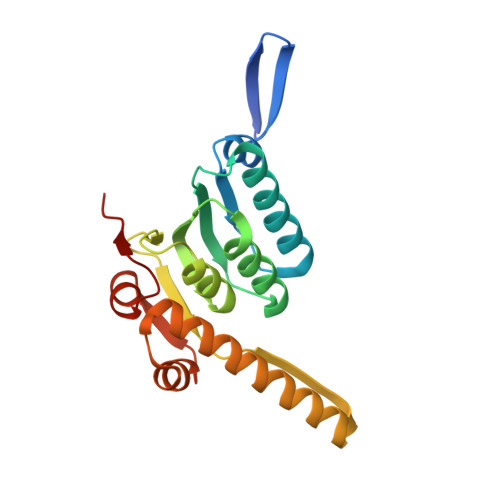Helix unfolding/refolding characterizes the functional dynamics of Staphylococcus aureus Clp protease
Ye, F., Zhang, J., Liu, H., Hilgenfeld, R., Zhang, R., Kong, X., Li, L., Lu, J., Zhang, X., Li, D., Jiang, H., Yang, C.-G., Luo, C.(2013) J Biological Chem 288: 17643-17653
- PubMed: 23625918
- DOI: https://doi.org/10.1074/jbc.M113.452714
- Primary Citation of Related Structures:
4EMM, 4EMP - PubMed Abstract:
The ATP-dependent Clp protease (ClpP) plays an essential role not only in the control of protein quality but also in the regulation of bacterial pathogen virulence, making it an attractive target for antibacterial treatment. We have previously determined the crystal structures of Staphylococcus aureus ClpP (SaClpP) in two different states, extended and compressed. To investigate the dynamic switching of ClpP between these states, we performed a series of molecular dynamics simulations. During the structural transition, the long and straight helix E in the extended SaClpP monomer underwent an unfolding/refolding process, resulting in a kinked helix very similar to that in the compressed monomer. As a stable intermediate in the molecular dynamics simulation, the compact state was suggested and subsequently identified in x-ray crystallographic experiment. Our combined studies also determined that Ala(140) acted as a "hinge" during the transition between the extended and compressed states, and Glu(137) was essential for stabilizing the compressed state. Overall, this study provides molecular insights into the dynamics and mechanism of the functional conformation changes of SaClpP. Given the highly conserved sequences of ClpP proteins among different species, these findings potentially reflect a switching mechanism for the dynamic process shared in the whole ClpP family in general and thus aid in better understand the principles of Clp protease assembly and function.
- State Key Laboratory of Drug Research, Shanghai Institute of Materia Medica, Chinese Academy of Sciences, Shanghai 201203, China.
Organizational Affiliation:
















